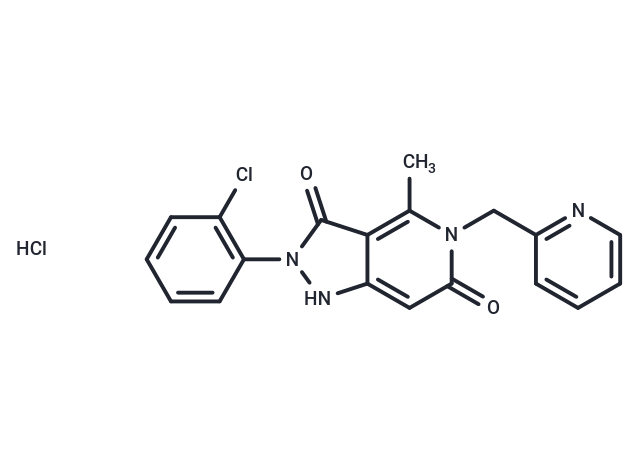Shopping Cart
- Remove All
 Your shopping cart is currently empty
Your shopping cart is currently empty

GKT136901 hydrochloride is a NOX-1/4 inhibitor, a selective scavenger of peroxynitrite, which inhibits METH-induced ROS production.

| Pack Size | Price | Availability | Quantity |
|---|---|---|---|
| 2 mg | $29 | In Stock |
| Description | GKT136901 hydrochloride is a NOX-1/4 inhibitor, a selective scavenger of peroxynitrite, which inhibits METH-induced ROS production. |
| Targets&IC50 | NOX4:165 nM (Ki), NOX1:160 nM (Ki) |
| In vitro | GKT136901 hydrochloride is a potent, selective and orally active NADPH oxidase (NOX1/4) inhibitor with Ki values of 160 nM and 165 nM, respectively. [1] GKT136901 hydrochloride significantly reduced the production of superoxide radical anion and H2O2 in MPT cells induced by high D-glucose and eliminated the effect of high D-glucose on p38MAP kinase activation in MPT cells after treatment with GKT136901 hydrochloride at a dose of 10 μM for 30 min. [3] GKT136901 hydrochloride attenuated methamphetamine (METH)-induced oxidative stress in HBMEC treated at a dose of 10 μM for 2 hours and effectively protected HBMEC from METH-induced blood-brain barrier (BBB) dysfunction. [5] |
| In vivo | GKT136901 hydrochloride exhibited nephroprotective effects in a mouse model of type 2 diabetes mellitus when administered orally at a dose of 30-90 mg/kg daily for 16 weeks. [6] |
| Alias | GKT-901 hydrochloride, GKT-771 hydrochloride, GKT-136901 hydrochloride, AK120765 hydrochloride, AK 120765 hydrochloride |
| Molecular Weight | 403.26 |
| Formula | C19H16Cl2N4O2 |
| Cas No. | 1254507-01-1 |
| Smiles | Cl.O=C1C=C2NN(C(=O)C2=C(N1CC3=NC=CC=C3)C)C=4C=CC=CC4Cl |
| Relative Density. | no data available |
| Storage | store at low temperature,keep away from moisture | Powder: -20°C for 3 years | In solvent: -80°C for 1 year | Shipping with blue ice. | ||||||||||||||||||||||||||||||||||||||||
| Solubility Information | H2O: 2 mg/mL (4.96 mM), Sonication is recommended. DMSO: 50 mg/mL (123.99 mM), Sonication is recommended. | ||||||||||||||||||||||||||||||||||||||||
Solution Preparation Table | |||||||||||||||||||||||||||||||||||||||||
H2O/DMSO
DMSO
| |||||||||||||||||||||||||||||||||||||||||

Copyright © 2015-2025 TargetMol Chemicals Inc. All Rights Reserved.